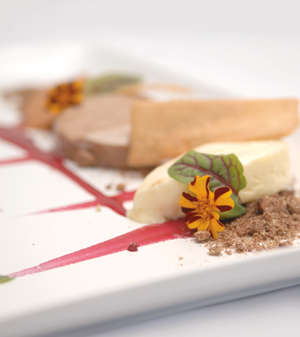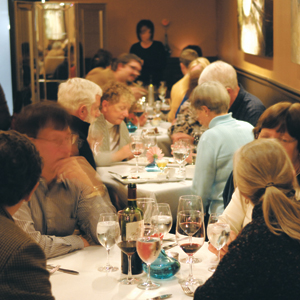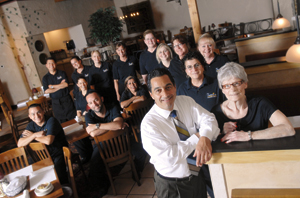 Written by Wini Moranville
Written by Wini Moranville
Photos by Duane Tinkey
You got that top at Banana Republic.”
This statement was my welcome, the first thing my server said to me one night as I sat down to a table at one of our city’s better chef-driven restaurants.
“Why, yes, I did,” I responded, thinking, good evening to you, too.
“Well,” she said. “I hope you didn’t pay full price for it. I was at Banana today, and that one’s on sale now.”
Reader, I wish I could tell you something—anything—else about that meal; I imagine the dessert was fabulous (signature desserts abound at this spot). Because it was autumn (something I do remember, thanks to the seasonality of the new top I paid full price for), I would imagine that there had been an artful presentation of braised meats and wonderful in-season root veggies. I’m sure I loved the wine—always thoughtfully chosen at this place.
But no. All the hard work, skillful food purveying, artistry and imagination that the chef had put into the meal have long been forgotten. All I really remember is feeling a bit foolish for having paid too much for an article of clothing.
That night took place nearly halfway through my 14 ½-year tenure as The Des Moines Register’s restaurant reviewer. Fortunately, soon after that, I began witnessing a near-meteoric rise in professionalism in service at our restaurants.
It’s been an interesting route to where we are today. In the late ’70s and early ’80s, when I waited tables, pretty much all it took was to take an order, get the food out and be pleasant and well-groomed. Knowledge of, let alone passion for, the food was not an integral part of the gig. (Case in point: I worked in a high-end seafood restaurant, where no one thought to educate us about the different kinds of fish we served.)
In the ’80s, haughtiness was in style at fine-dining venues—remember the snooty waiters whom you felt you had to impress? Later, a more casual bistro scene emerged. Gone were the tuxedoed maitre d’s, chandeliers and red roses on the white-clothed tables, in favor of more edgy, energetic dining rooms with open kitchens and an unmistakable buzz.
With that, oftentimes, came a style of service that could hover around the too-casual mark. Arrogance was out, thank heavens, but suddenly, some servers wanted to be your buddy; after the meal was over, you might know a little more about them than you really wanted to.
These days, most of our best restaurants have attracted a professional class of servers who key into the middle ground between too stiff and too talky. And even though they seem as passionate and knowledgeable about the food as the chef, they know when to chat and when to hang back. These intuitive pros “read” the table, discerning how much or how little their guests wish to interact with them, and they calibrate their approach to the table accordingly.
I recently chatted with the owners of Tursi’s Latin King, Baru 66 and Proof about the philosophies behind the style of service each hopes to achieve. What they shared shows that, in many of this town’s best venues, the service that diners encounter in the front of the house is wrought with as much skill and passion as the cuisine that comes from the kitchen.
 Baru 66:
Baru 66:
True-to-France Service
I once casually mentioned to Baru 66’s chef and co-owner, David Baruthio, that I’d long harbored a secret dream of learning the art of authentic French-style service.
“I could get you a job at a restaurant in France, where you could train,” he offered.
“Really?” I said, somewhat flattered. “Do you really think my French is good enough to actually work in a French restaurant—in France?”
He furrowed his brow, exhaled one of those long Gallic sighs of exasperation, and said: “You think they’d let you talk to the customer? Non! When you train to be a server in France, they won’t even let you speak to a table for six months.”
Suffice it to say that French-born Baruthio expects his staff to have a certain polish and finesse; he strives for the kind of world-class service he became accustomed to in the four- and five-star venues he’s worked in from Belgium to Beverly Hills.
“Service should be courteous, professional, and not too casual,” he says, adding that the servers must anticipate the guest’s desires before the guest even knows he or she needs something.
That means the exact cutlery you need appears just before the dish emerges from the kitchen; wine glasses are silently filled from temperature-correct bottles. Plates vanish when they’re no longer needed, and the cheese trolley rolls up just when you’re ready—all done with the minimum amount of intrusion.
Most nights, dashingly dressed co-owner Sara Hill (who is also Baruthio’s wife) plays the role of eagle-eyed maitre d’, ensuring that all runs seamlessly in the front of the house. Hill, who is also a jewelry designer, compares the art of service to the art of jewelry making. She wants the precision, grace and beauty that she brings to her finished designs to be present in her dining room as well.
“It’s all in the details,” she says.
 Tursi’s Latin King:
Tursi’s Latin King:
Classic American Service
There are few restaurants in town where the front-of-the-house triumvirate—host, server, busboy—still exists. Here’s how it works: The gregarious host (usually the owner) greets and seats and constantly scans the room for breakdowns; career servers manage the table, while committed busboys keep the place humming along, clearing plates, filling water glasses, setting up tables for the next round of diners.
It’s an old-school model, but that’s still what goes down, night after night, at Tursi’s Latin King. With as many as 40 employees on the floor on a given shift, the restaurant is run like tight ship.
Owner Bob Tursi is the ship’s captain, and he’s there nearly every night. In fact, when he’s not in his restaurant, he spends his time worrying about whether his customers are being taken care of. “I’m phobic about service,” he says.
Phobic is not the word you would use describe the man who greets you when you walk through the Latin King’s revolving door. No matter how full the lobby—where diners can wait for a table an hour or more, especially on weekends—Tursi welcomes you into his restaurant as if you’re the one he’s been looking for all night.
But it doesn’t end there. If you go to the Latin King, watch Tursi in operation now and then. One moment, he can be casually chatting with a diner; the next, with almost animalistic instinct, he spots something wrong—a glass nearly unfilled, a table waiting for a check—and before the diner has thought to flag anyone down, Tursi is on his staff, and they are on it.
Tursi got his start in the business at the former Crystal Tree restaurant—a chandeliered, white-tablecloth, special-occasion spot that was especially popular in the ‘70s and ‘80s. He recalls being taught—drilled, in fact—that diners had high expectations for service when they came to the Crystal Tree.
Three decades later, Tursi’s Latin King may be more casual than the Crystal Tree, but its owner wants you to have equally high expectations when you walk through his door.
 Proof:
Proof:
A New Style of Service
Proof co-owner Zachary Mannheimer may wear a hoodie when he trains the staff and then manages the floor on Friday nights, but don’t mistake this casualness for someone who doesn’t know his stuff. He’s worked at venues in London and New York City (where he’s waited on the likes of Oprah Winfrey and former Walt Disney Co. CEO Michael Eisner); he was also the maitre d’/sommelier of the Embassy Club in Des Moines. (Disclosure: Mannheimer also is contributing wine writer and blogger for dsm.)
Mannheimer’s day job is as the executive director of the Des Moines Social Club, an art/theater club that, he notes, produces more than 250 events a year, including many theater productions. For his modern-day style of service, he says there should be a theatricality to the evening.
“The servers should operate like trained dancers,” he says. “They should be constantly moving elegantly through the room, stopping to chat when they need to, but otherwise exchanging moves with the rest of the staff.”
Hence, he pushes his staff in much the same way he pushes actors in his theater productions. He expects the entire staff to follow his well-choreographed “17 approaches to the table”—17 specific moments in a two-hour dining experience in which the staff must engage the table (many of which are performed silently). He demands that his servers know everything about every dish—not only what’s in it, but how it’s cooked.
“With knowledge comes confidence,” says Mannheimer, who is quick to point out that he wants his servers to exude confidence, but never snootiness or arrogance (hence, the occasional hoodie).
He also wants his servers to be equally knowledgeable about the diners they serve.
“All you need to know about a diner is five things,” he says. “Their price point, how long they wish to dine, how adventurous they are, what they’ve had before and liked, and allergies or food aversions.”
With this, he says, diners shouldn’t even need a menu. In fact, his goal is to not have menus in his restaurant at all. In his view, the preferences of repeat guests should be thoroughly understood by the intuitive staff.
“The guest should be able to come in, sit down, look at the server, and say, ‘Feed me.’”






